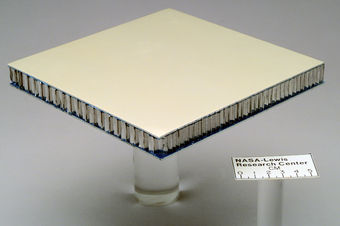- Sandwich-structured composite
-
A sandwich-structured composite is a special class of composite materials that is fabricated by attaching two thin but stiff skins to a lightweight but thick core. The core material is normally low strength material, but its higher thickness provides the sandwich composite with high bending stiffness with overall low density.
Open- and closed-cell-structured foams like polyvinylchloride, polyurethane, polyethylene or polystyrene foams, balsa wood, syntactic foams, and honeycombs are commonly used core materials. Open- and closed-cell metal foam can also be used as core materials.
Laminates of glass or carbon fiber-reinforced thermoplastics or mainly thermoset polymers (unsaturated polyesters, epoxies...) are widely used as skin materials. Sheet metal is also used as skin material in some cases.
The core is bonded to the skins with an adhesive.
Contents
History
A summary of the important developments in sandwich structures is given below.[1]
- 230 BC Archimedes describes the laws of levers and a way to calculate density.
- 25 BC Vitruvius reports about the efficient use of materials in Roman truss roof structures.
- 1493 Leonardo da Vinci discovers the neutral axis and load-deflection relations in three-point bending.
- 1570 Palladio presents truss beam constructions with diagonal beams to prevent shear deformations.
- 1638 Galileo Galilei describes the efficiency of tubes versus solid rods.
- 1652 Wendelin Schildknecht reports about sandwich beam structures with curved wooden beam reinforcements.
- 1726 Jacob Leupold documents tubular bridges with compression-loaded roofs.
- 1786 Victor Louis uses iron sandwich beams in the galleries of the Palais-Royal in Paris.
- 1802 Jean-Baptiste Rondelet analyses and documents the sandwich effect in a beam with spacers.
- 1820 Alphonse Duleau discovers and publishes the moment of inertia for sandwich constructions.
- 1830 Robert Stephenson builds the Planet locomotive using a sandwich beam frame made of wood plated with iron
The 1940 de Havilland Mosquito was built with sandwich composites; a balsa-wood core with plywood skins.[2]
Types of sandwich structures
Metal composite material (MCM) is a type of sandwich formed from two thin skins of metal bonded to a plastic core in a continuous process under controlled pressure, heat, and tension.[3]
Recycled paper is also now being used over a closed-cell recycled kraft honeycomb core, creating a lightweight, strong, and fully repulpable composite board. This material is being used for applications including point-of-purchase displays, bulkheads, recyclable office furniture, exhibition stands, and wall dividers.
To fix different panels, among other solutions, a transition zone is normally used, which is a gradual reduction of the core height, until the two fiber skins are in touch. In this place, the fixation can be made by means of bolts, rivets, or adhesive.
Properties of sandwich structures
The strength of the composite material is dependent largely on two factors:
-
- The outer skins: If the sandwich is supported on both sides, and then stressed by means of a force in the middle of the beam, then the bending moment will introduce shear forces in the material. The shear forces result in the bottom skin in tension and the top skin in compression. The core material spaces these two skins apart. The thicker the core material the stronger the composite. This principle works in much the same way as an I-beam does.[4]
- The interface between the core and the skin: Because the shear stresses in the composite material change rapidly between the core and the skin, the adhesive layer also sees some degree of shear force. If the adhesive bond between the two layers is too weak, the most probable result will be delamination.
The theory is available on the Sandwich theory page.
See also
- Honeycomb Structures
- Sandwich theory
References
- ^ http://www.econhp.de/history-without-flash.html
- ^ Cutler, John Henry; Koppel, Ivan; Liber, Jeremy. Understanding Aircraft Structures. Blackwell Publishing Limited. p. 14. ISBN 1-4051-2032-0.
- ^ Flanagan, Jim (2007). "The Realm of Building Possibilities Created by MCM and Insulated Metal Panels". Metal construction news 28 (10). http://d.wanfangdata.com.cn/NSTLQK_NSTL_QK14842580.aspx.
- ^ Gere, James M (2004). Mechanics of Materials. Thomson Brooks/Cole. pp. 393–463. ISBN 0-534-41793-0.
External links
- SandwichPanels.org – Composite sandwich structure information
- Diab Sandwich Handbook
- Honeycomb Sandwich Design Technology
Categories:- Composite materials
- Aerospace materials
Wikimedia Foundation. 2010.


